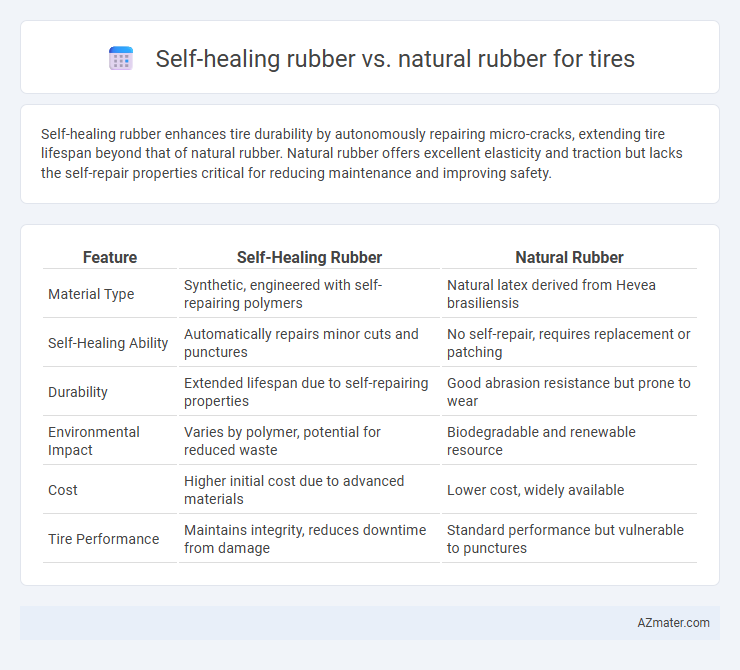Self-healing rubber enhances tire durability by autonomously repairing micro-cracks, extending tire lifespan beyond that of natural rubber. Natural rubber offers excellent elasticity and traction but lacks the self-repair properties critical for reducing maintenance and improving safety.
Table of Comparison
| Feature | Self-Healing Rubber | Natural Rubber |
|---|---|---|
| Material Type | Synthetic, engineered with self-repairing polymers | Natural latex derived from Hevea brasiliensis |
| Self-Healing Ability | Automatically repairs minor cuts and punctures | No self-repair, requires replacement or patching |
| Durability | Extended lifespan due to self-repairing properties | Good abrasion resistance but prone to wear |
| Environmental Impact | Varies by polymer, potential for reduced waste | Biodegradable and renewable resource |
| Cost | Higher initial cost due to advanced materials | Lower cost, widely available |
| Tire Performance | Maintains integrity, reduces downtime from damage | Standard performance but vulnerable to punctures |
Introduction to Self-Healing Rubber and Natural Rubber
Self-healing rubber incorporates microcapsules or dynamic bonds that enable automatic repair of cracks, significantly enhancing tire durability and lifespan. Natural rubber, derived from the latex of Hevea brasiliensis trees, offers excellent elasticity and resilience, making it a traditional material for tire manufacturing. The innovative self-healing rubber merges polymer science advancements with natural rubber's elasticity to reduce maintenance and improve tire safety.
Composition and Chemical Structure
Self-healing rubber incorporates dynamic covalent bonds or supramolecular interactions within its polymer matrix, enabling the material to autonomously repair micro-cracks and extend tire lifespan. Natural rubber consists primarily of cis-1,4-polyisoprene, a linear polymer with high elasticity due to its unsaturated hydrocarbon chains and limited crosslinking. The chemical structure of self-healing rubber is engineered with responsive functional groups that facilitate reversible bonding, contrasting with the permanent crosslinked network of natural rubber, which lacks self-repair capabilities.
Mechanisms of Self-Healing in Rubber
Self-healing rubber incorporates dynamic covalent bonds or supramolecular interactions that enable automatic repair of microcracks, restoring mechanical integrity and prolonging tire lifespan. Natural rubber relies on its intrinsic elasticity and vulcanization network but lacks inherent self-repair capabilities, making it susceptible to irreversible damage from wear and tear. Advances in self-healing mechanisms, such as reversible disulfide bonds or hydrogen bonding, enhance durability and safety by enabling tires to recover from punctures and abrasions without external intervention.
Durability and Lifespan of Tires
Self-healing rubber significantly enhances tire durability by autonomously repairing micro-cracks and punctures, extending the tire's lifespan beyond that of traditional natural rubber, which degrades faster due to environmental wear and mechanical stress. The molecular structure of self-healing rubber incorporates reversible bonds or embedded agents that activate upon damage, reducing the frequency of tire replacements. Natural rubber, while offering excellent flexibility and traction, lacks the inherent repair mechanisms, leading to a shorter effective lifespan under similar conditions.
Performance in Various Driving Conditions
Self-healing rubber enhances tire durability by automatically repairing minor cuts and abrasions, maintaining tire integrity under rough terrains and off-road conditions. Natural rubber excels in providing superior grip and flexibility, optimizing traction and performance on wet and dry roads through its inherent elasticity. The integration of self-healing properties into rubber compounds offers a significant advantage in extending tire lifespan without compromising the natural rubber's exceptional handling characteristics across diverse driving environments.
Environmental Impact and Sustainability
Self-healing rubber significantly reduces waste by extending tire lifespan through autonomous repair of micro-damages, decreasing the frequency of tire replacement compared to natural rubber tires. The production of self-healing rubber often incorporates advanced polymers with enhanced recyclability, minimizing environmental pollution relative to the extraction and processing-intensive natural rubber. Sustainable tire manufacturing benefits from self-healing technologies by lowering carbon emissions and resource consumption, positioning them as a viable eco-friendly alternative to traditional natural rubber tires.
Manufacturing Process and Cost Comparison
Self-healing rubber incorporates microcapsules or reversible polymer networks that enable the material to autonomously repair damage, requiring advanced synthesis techniques and specialized curing processes compared to traditional natural rubber manufacturing. Natural rubber production involves latex extraction from Hevea brasiliensis, followed by coagulation, drying, and vulcanization, making it more straightforward and cost-effective. The complex manufacturing process of self-healing rubber results in higher material and processing costs, while natural rubber remains economically favorable for large-scale tire production due to its established supply chain and lower production expenses.
Safety and Reliability on the Road
Self-healing rubber enhances tire safety by automatically repairing micro-cracks and punctures, reducing the risk of sudden tire failure and maintaining consistent traction. Compared to natural rubber, it offers superior reliability under various road conditions by preserving tire integrity longer and minimizing blowouts. This technology improves overall vehicle stability and helps prevent accidents caused by tire damage.
Market Availability and Industry Adoption
Self-healing rubber for tires is emerging with limited market availability compared to widely accessible natural rubber, which remains the industry standard due to well-established supply chains. Major tire manufacturers are gradually testing self-healing rubber technologies for enhanced durability but have yet to achieve large-scale adoption. Natural rubber maintains dominance in market share and production volume, while self-healing variants are primarily confined to research and niche applications.
Future Prospects and Innovations in Tire Technology
Self-healing rubber presents promising future prospects in tire technology by significantly enhancing durability and safety through its ability to automatically repair micro-cracks, reducing maintenance costs and extending tire lifespan compared to traditional natural rubber. Innovations such as incorporating microcapsules containing healing agents or dynamic covalent bonds enable real-time restoration of tire integrity under stress, positioning self-healing materials as a transformative solution for next-generation tires. Research continues to optimize the balance between self-healing efficiency, mechanical strength, and environmental sustainability, driving the evolution of smarter, more resilient tires in the automotive industry.

Infographic: Self-healing rubber vs Natural rubber for Tire
 azmater.com
azmater.com